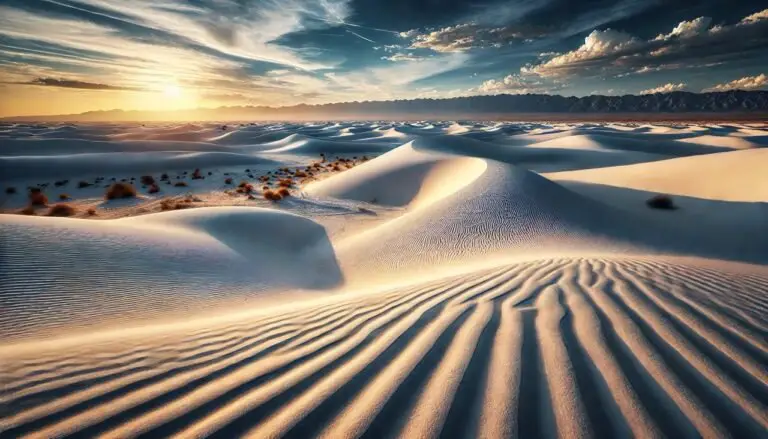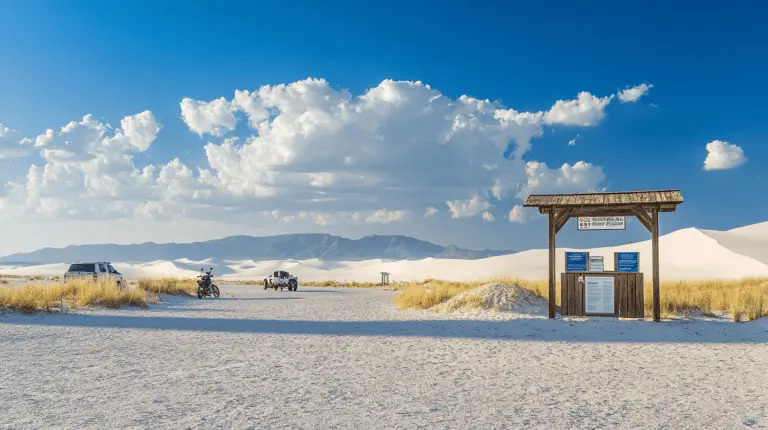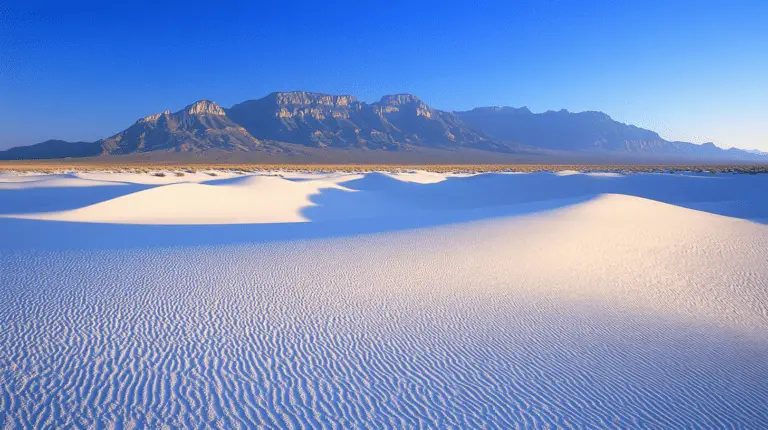White Sands National Park Geology
The geological formation at White Sands National Park is a sight that intrigues geology buffs and casual visitors alike. This park, with its expansive gypsum dunefield, is simply breathtaking.
How the Gypsum Dunefield Began
White Sands’ gypsum dunefield got its start over 280 million years ago. Back then, the area lay under the Permian Sea, which left behind gypsum on the sea floor (NPS – White Sands National Park). This led to the spectacular gypsum landscape we now marvel at.
Gypsum’s a pretty common mineral around the globe, but it usually doesn’t show up as sand because water can dissolve it. The dunes began forming as the water in the region evaporated, leaving behind gypsum crystals. Over time, these broke down into tiny grains, creating the dunes we see today (NASA Earth Observatory).
The White Sands dunefield covers a whopping 275 square miles, making it the largest gypsum dunefield on the planet. Some dunes even tower up to 60 feet high, creating a stunning and nearly otherworldly landscape (Wikipedia).
| Feature | Description |
|---|---|
| Dunefield Size | 275 sq mi |
| Park Area | 145,762 acres |
| Dune Height | Up to 60 feet |
| Gypsum Sand Estimate | ~4.5 billion tons |
What’s in the Sand
Sand here at White Sands is defined as any particle between 0.065 millimeters to 2 millimeters (NPS – White Sands National Park). What sets these dunes apart from most deserts is that they are made primarily of gypsum, not the quartz sands you usually see.
Gypsum sand comes from larger gypsum crystals breaking down. Thanks to the unique local conditions, the gypsum didn’t dissolve but stayed put and eventually formed these iconic white dunes that draw crowds every year.
Planning a visit? Check out our page on sand composition and other geological features. Knowing these facts can make your trip to White Sands even more memorable.
For more about the park’s development history and its environmental impact, browse our other articles. They’ll give you a deeper understanding and appreciation of this unique destination.
Also, check out White Sands Missile Range and Alamogordo White Sands to round out your travel plans and geological adventures.
A Journey Through Time
Ancient Sea Stories
Way back—like 280 to 250 million years back—the Permian Sea covered parts of what we now call the southwestern U.S. Southern New Mexico wasn’t the dry, dusty place we see today; it was underwater. This ancient sea was a mineral goldmine, depositing layers of gypsum and other treasures on its floor. Fast forward a few epochs, and you get the breathtaking White Sands National Park we adore (NPS).
Ice Age Shake-Up
Jump ahead to about 24,000 to 12,000 years ago, when ice and snow ruled. As they melted, they carried dissolved gypsum from the mountains into Lake Otero—a massive body of water that once dominated the area. But, as the Ice Age said its goodbyes, Lake Otero dried up, leaving a dusty lake bed behind. This shift was crucial for crafting the stunning sight we see today in White Sands. For more nitty-gritty details, visit White Sands National Park History.
From Lake to Desert
Fast forward to about 10,000 years ago and hello, Chihuahuan Desert. As Lake Otero faded away, Alkali Flat and Lake Lucero emerged. Here, big selenite crystals started forming in Alkali Flat. Meanwhile, desert winds whipped up smaller gypsum particles, creating the vast white sand dunes that White Sands is famous for today (NPS.gov). Dive deeper into these changes on our White Sands Geology page.
- Ancient Sea: 280 to 250 million years ago.
- Ice Age Era: 24,000 to 12,000 years ago.
- Modern Desert: 10,000 years ago to now.
So there you have it, folks—a mind-blowing geological tale. Feel the history under your feet as you wander through White Sands National Park. Each step on those dunes is a step through time.
Formation Processes
At White Sands National Park, the creation of its sparkling gypsum dunes is nothing short of magical. Let’s break down the key processes that give rise to these natural wonders.
Lake Lucero’s Role
Lake Lucero is where the magic begins. Rain, snowmelt, and water seeping up from inside the basin fill the lake with gypsum-rich water. As the water evaporates, selenite crystals (that’s a fancy name for a type of gypsum) start to form on the lakebed. These crystals then get broken down by the wind and water into fine gypsum sand, creating the breathtaking dunes people flock to see. Curious for more? Check out our White Sands National Park page.
| Stage | What’s Happening |
|---|---|
| Filling | Rain and melting snow fill the lake. |
| Evaporation | Water goes poof, leaving selenite behind. |
| Breakdown | Crystals turn into fine, white gypsum sand. |
Birth of Selenite Crystals
Selenite crystals form when the water in Lake Lucero evaporates. This isn’t a one-time gig; it happens over thousands of years, with a major crystal boom every 10 to 14 years during big floods. Over time, wind and water grind these crystals down into tiny, white grains of gypsum sand. For more on this quirky process, check out the geology of White Sands.
Making Gypsum Sand
The Big Deal about gypsum sand is that it’s rare. Gypsum usually dissolves in water, but here it’s left behind as the water evaporates. The water bodies in the park’s basin have no escape routes, so they dry up and leave gypsum sit around. Over many years, these gypsum crystals get broken down into sand by the elements. The wind then takes over, pushing the gypsum grains across the park, creating dunes.
| Stage | What’s Happening |
|---|---|
| Deposit | Gypsum gets left behind by evaporating water. |
| Breakdown | Crystals crumble into sand grains. |
| Wind | Sand grains move, forming dunes. |
With wind speeds hitting 20 mph, you can see gypsum sand piling up fast—about 2 inches in an hour! Want to geek out more? Visit the New Mexico Bureau of Geology & Mineral Resources.
Best of all, you can witness these processes up close! Don’t leave without stopping by the White Sands National Park visitor center.
Natural Resources
Gypsum: The Charm Behind White Sands
Gypsum, the magic behind the stunning white sands, is a rockstar of versatility. At White Sands National Park, it morphs into various avatars like selenite crystals and alabaster. This mineral is the unsung hero in many fields:
- Wallboard: The backbone of your drywall.
- Medical: That lifesaver in casts for broken bones.
- Construction: Keeps cement from setting too fast.
- Agriculture: Your soil’s best buddy.
- Beverages: The secret ingredient that makes your beer better.
Curious about more everyday magic of gypsum? Dive into the details at white sands national park gypsum.
When Wind Plays Sculptor
Ever wonder who crafts those stunning dunes at White Sands NP? It’s the wind with some serious artistic flair. With gusts hitting around 20 miles per hour (32 kilometers per hour), here’s the magic it weaves:
- Magic Wand: Deposits around 5 centimeters (2 inches) of new sand in an hour.
- Architect: Builds higher, steeper dune crests.
Want to understand wind’s dance better? Peek into the white sands national park weather that choreographs this sandy symphony.
Wind, Water: The Dynamic Duo
Rain, snowmelt, and groundwater from the surrounding mountains make sure Lake Lucero stays hydrated with gypsum-laden waters. When the water evaporates, tiny selenite crystals are left. These break down, thanks to wind and water teamwork, into the white gypsum sand we adore.
Wind and water’s endless waltz is what keeps shaping the dunes at White Sands National Park. The park’s geology is like a living, breathing entity, constantly changing thanks to this dance-off of natural forces.
Want to know more about this fascinating process? Discover more at white sands national park history and watch how Mother Nature continuously molds this unique beauty.
Park Development
Dive into the wild tale of White Sands National Park and how it skyrocketed from monument status to national treasure.
History That Packs a Punch
White Sands National Park is a storybook filled with stunning geological sights and rich cultural nuggets. It all kicked off in 1933 when it was named a national monument because of its awe-inspiring gypsum dunes. The scenery caught the eyes of scientists, tourists, and nature buffs alike.
Then, in 2019, President Donald J. Trump bumped it up to full national park status, locking down its place among America’s natural gems and safeguarding its ecosystems and ancient mysteries. Why the change? To protect the one-of-a-kind dunes and those jaw-dropping Ice Age fossilized footprints.
| Year | Event |
|---|---|
| 1933 | Became White Sands National Monument |
| 2019 | Now White Sands National Park |
From Monument to Star Attraction
December 20, 2019, is the date that took White Sands from just another monument to national park fame. Now, it’s a must-see, showcasing the world’s biggest gypsum dunefield and holding onto some seriously cool natural and cultural oddities. Think fossilized footprints from the Ice Age kind of cool (NPS.gov).
Hungry for more history? Check out our detailed write-up on white sands national park history.
Always Getting Better
White Sands isn’t resting on its sandy laurels. They’re always improving to make your visit even sweeter (NPS.gov). From swanky new facilities to better accessibility and packed educational programs that dive into the nitty-gritty of dune life, Tularosa Basin history, and yes, even how not to roast in the desert.
Got wanderlust? Join one of the fresh guided tours and swing by the improved visitor center for all the latest. Planning your trip? Check the park hours, so you don’t miss a thing.
Get ready to walk the sands of time and soak in the jaw-dropping beauty and history that White Sands National Park serves up!
Environmental Impact
The Wind’s Dance
At White Sands National Park, the wind has its own choreography. Gypsum grains fly into the air, sculpting ever-changing dunes. When the wind hits 20 mph (32 km/h), those sand grains stack up on the crests like nature’s own Jenga game, adding almost 2 inches (5 cm) every hour. And when a sandstorm kicks up, with gusts reaching 35-40 mph (55-65 km/h), even broken shrubs join the airborne spectacle, adding to the shifting landscape.
Desert Survivors: The Plants
The plants here are the true heroes, taking on the harsh gypsum dunes. The soaptree yucca and skunkbush sumac dive deep with their roots, anchoring themselves and hunting for water buried beneath. Some plants aren’t just sitting around either—they grow fast enough to avoid getting buried alive. Check out our guide on plants in White Sands National Park for more on these green warriors.
Dune Choreography
Wind doesn’t just move sand; it sculpts art. Gypsum grains get caught up in the wind, smashing into each other and the desert floor, gradually shrinking and creating new forms. Wind direction is like a maestro, guiding the dance of sand and forming unique patterns. For a deeper look into this mesmerizing process, head over to our section on White Sands dunes.
Here’s a snapshot of what wind does at White Sands:
| Wind Speed | Effect | Sand Deposits |
|---|---|---|
| 20 mph (32 km/h) | Sand stacks on dunes | ~2 inches (5 cm) per hour |
| 35-40 mph (55-65 km/h) | Moves shrubs, changes dunes | More dynamic shifting |
White Sands National Park isn’t just standing still. It’s a living, breathing example of nature’s power to shape and reshape the world. Want to see it up close? Get all the details on White Sands National Park hours and visitor center info.








